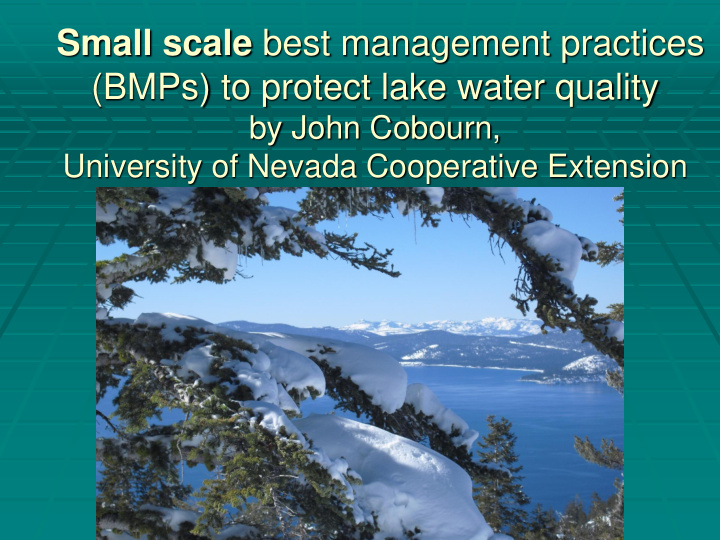



Small scale best management practices (BMPs) to protect lake water quality by John Cobourn, University of Nevada Cooperative Extension
Greatest Threats to Water Quality NUTRIENTS feed algae suspended in water FINE SEDIMENTS also remain suspended in the water Worst sediments are .5-10 microns 72% of fine sediment comes from urban runoff
We have two kinds of “sewer” systems Runoff from streets, parking lots and rooftops is the enemy . It is not “treated.”
BMPs are Required at Tahoe All we have is Nonpoint Source Pollution at Tahoe TRPA Code of Ordinances defines “BMP Retrofit” These BMPs are for single family homes and small businesses
The Steps of BMP Retrofit 1. Free BMP Site evaluation from TRPA or Conservation Districts 2. Install the required BMPs 3. A Conservation District or TRPA does an inspection, and TRPA issues a Certificate of BMP Completion
How BMPs work 1. “ Source Control ”: Vegetate and mulch bare soil to prevent erosion 2. “Infiltration”: Concentrated runoff from rooftops and pavement needs extra help to infiltrate (storage in a system)
Five Main Categories of Small Scale BMPs 1. Temporary (construction) BMPs 2. Paving and properly Draining Driveways 3. Infiltrating runoff into the soil 4. Vegetating and mulching bare soil 5. Stabilizing steep slopes Each type of BMP has its own Chapter in the Contractors BMP Manual (3 ring binder)
1. Temporary BMPs Use during construction or any soil disturbance
2. Paving Driveways Driveways must convey runoff to an infiltration system or flat, vegetated area
Prevent concentrated runoff from reaching the street by installing a swale or channel drain across the foot of the driveway.
3. Infiltration Systems Keep the water from leaving the property. Install a sediment trap for ease of maintenance Unless soil has rapid permeability, runoff water usually needs to be stored Water infiltrates after the rain event has ended Examples — Next 12 slides!
Dripline trench with containment border
Dripline trench with cobble border
Armored Drip Line Treatments Drain Rock with Containment Borders
Armor under Elevated Structures
Prefabricated Infiltration Systems (Rainstore) 94% void space!
Rock Lined Basins Maximum 2:1 side slope Level bottom Match contour of slope Incorporate armored spillway for potential basin overflow
Vegetated Basins Maximum 2:1 side slope Level bottom Match contour of slope Incorporate armored spillway for potential basin overflow
Conveyance Swales Rock lined Vegetated
Natural Infiltration or Water Spreading can work when there is a flat lawn or well vegetated area
4. Vegetate and Mulch Bare Soil Landscape should absorb water like a sponge Use both Native AND Adapted plants Recommended plant list Heavy rain will wash unprotected soil into the street.
Cover bare soil with vegetation and/or mulch (Appropriate turf)
Noncombustible Lean, Clean, and Green Wildland Fuel Reduction
5. Slope Stabilization Structures needed for all slopes over 50%. Combine with vegetation for best results. Slope: Divide the Rise by the Run. If you have 1/2, divide 1 by 2 and you get .5 or 50%. (also known as a “2 to 1 slope”).
Slope Stabilization structures
BMPs Need to be Maintained Even newer homes need BMP Retrofit if BMPs have not been maintained.
Teach BMP Installation in Spanish
Recommend
More recommend